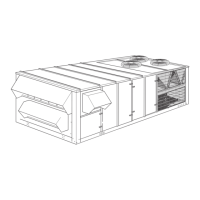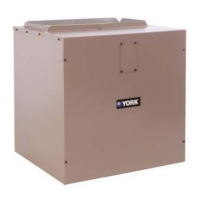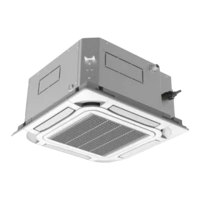Do you have a question about the York MILLENNIUM Y24 and is the answer not in the manual?
Important safety information and warnings for installation and servicing of HVAC equipment.
Installer attention to specific terms like NOTE, CAUTION, and WARNING.
Emergency procedures to follow if a gas leak is detected.
Conformance requirements for installation codes and standards (ANSI, NFPA).
Requirements for field wiring, disconnect switches, and branch circuits.
Sizing of gas piping based on flow rate, gravity, and length, following codes.
Data and examples for correcting CFM, static pressure, and power.
Steps to adjust blower speed by changing motor sheave pitch diameter.
Step-by-step instructions for igniting and safely shutting down the gas furnace.
Essential checks after energizing the heating section and adjusting gas pressure.
Procedure for measuring natural gas consumption using a test dial meter.
How cooling stages are enabled based on ambient temp and head pressure control.
How head pressure control manages condenser fan speed for cooling.
Step-by-step operation of head pressure control during cooling.
How the APS verifies fan operation and triggers alarms.
Using economizer to maintain SAT within setpoints for improved comfort.
How economizer modulates dampers to maintain SAT within band.
How compressors or heating stages are added or removed to maintain SAT.
How OAT is used to disable cooling when too low.
Function of the freeze stat and its effect on hot water valve and economizer.
How economizer interacts with thermostat and SAT control.
Algorithm for controlling supply duct static pressure via VFD or vanes.
Control logic for Morning Warm-Up and VAV heating function.
How excessive SAT in cooling is managed and prevented.
How economizer loading minimizes SAT swings during cooling.
Criteria for choosing the best free cooling decision strategy.
PI algorithm for controlling SAT using economizer.
How economizer affects compressor operation and staging.
How the PI algorithm adjusts SAT using economizer in cooling.
How economizer loading works in heating and its benefits.
How IAQ sensor input controls economizer for ventilation.
Proportional control of exhaust using EAD and building pressure.
Monitoring compressor status via VAC circuits and safety switches.
Flashing patterns indicating unit status and errors.
How the control stores and manages error data.
How the control responds to failures of various sensors (SAT, RAT, OAT, etc.).
Specific operation when SAT, RAT, OAT, or Humidity sensors fail.
Response to failures of space, building pressure, duct static, and IAQ sensors.
Specific errors like SAT failure, Fan failure, Compressor trip, etc.
Using LEDs and buttons for diagnostics and status checks.
How the control stores alarms and maintenance data.
Understanding PI algorithm and software terms like EPROM.
Descriptions of AI points like ST, OAT, OAH, SAT, RAT, RAH, DPS, BPS.
Detailed list of all Simplicity control inputs and their specifications.
Procedure for the Run Test commissioning function.
Information on refrigerant charge, TXVs, and moisture/liquid sight glass.
Filter drier replacement and compressor protection features.
Safety features for combustion air and furnace rollout detection.
| Cooling Capacity | 24000 BTU/h |
|---|---|
| EER | 10.5 |
| Refrigerant | R-410A |
| Type | Split System |
| Sound Level | 50 dB(A) |
| Weight | Indoor: 13.5 kg, Outdoor: 52 kg |
| Power Supply | 208-230V, 1Ph, 60Hz |












